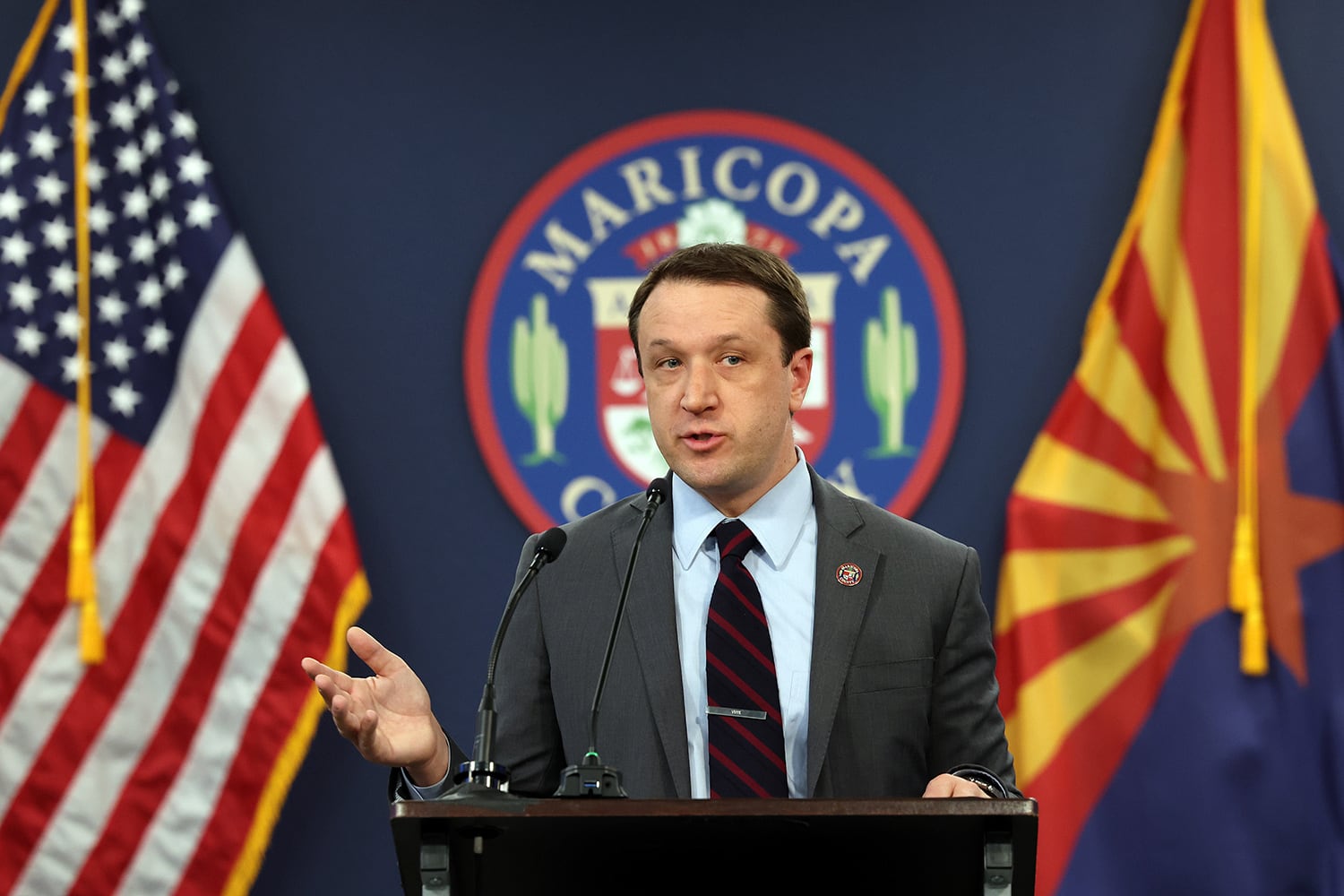Votebeat is a nonprofit news organization reporting on voting access and election administration across the U.S. Sign up for our free newsletters here.
The officials who run Arizona’s elections put out a blunt reminder last week: If lawmakers don’t soon change key dates related to the upcoming presidential election, military voters may get their ballots late, and results might not be delivered to Congress in time.
Their letters, addressed to Gov. Katie Hobbs and Senate President Warren Petersen, raise important questions: Why is Arizona the only state that appears to be facing this conundrum, and how can it be solved?
Votebeat’s review of election timelines and voting rules across multiple states shows a combination of factors in Arizona have created a long, unique, and unforgiving timeline for the upcoming election. Those factors include a new state law that basically guarantees recounts every election and a new federal law hardening a deadline for the presidential race, but also the state’s voter-friendly rules for mail ballots and a long timeframe for counting ballots.
Other states have a shorter mail ballot timeframe, faster counting laws, quicker certification dates, less risk of recounts — or a combination of the above — which allow them to get everything done faster, according to Votebeat’s review.
A spokesperson for the Massachusetts Secretary of the Commonwealth said even with the state’s quicker counting laws and fewer recounts, deadlines are still tight. “We are lucky we are not a swing state,” communications director Debra O’Malley said.
There are potential remedies in Arizona, and the governor may soon call a special session that would fast-track solutions. But it is proving tricky to get Republican lawmakers and county officials aligned. And they must propose changes that won’t be vetoed by Democratic Gov. Katie Hobbs.
If lawmakers don’t change the timeline by March 1, the current calendar is locked in for good because of an important candidate-related deadline on March 2, said Jen Marson, executive director of the Arizona Association of Counties.
But Hobbs didn’t mention the issue in her state of the state speech on Monday, the first day of the legislative session, which worried some who hoped it would be a priority when the session began. Maricopa County Supervisors Chairman Jack Sellers sent out a statement the next day urging elected leaders in both parties to act quickly, saying “a solution cannot wait any longer.”
Not everyone sees the timeline as problematic, though. Michelle Ugenti-Rita, a Republican and former state senator who sponsored the new recount law and is now running for Maricopa County supervisor, called the issue a “red herring” and said election officials are no longer credible because of mistakes they have made running elections.
“They constantly change why they can’t do something,” she said. “They can never, ever, do their job.”
Overall, election directors say they need to compress their primary plan by 19 days to fit between the Aug. 6 primary and Sept. 21, the day general election ballots need to be sent to military voters. And they say they need to cut their general election plan by 17 days to meet a Dec. 11 presidential elector deadline. Many of the cuts would require changes to state law.
Here’s where the timeline could be tightened, and potential roadblocks.
Primary date
Widening the timeline between the primary and general election would give officials more time. Arizona’s primary election, on Aug. 6, is one of the later primaries among the states, though by far not the latest.
The county association has proposed moving it up by a week or two, to July 24 or July 30. This may be a hard sell to incumbent candidates in the state Legislature who use the time after the session ends to focus on their campaigns — including sometimes collecting contributions from lobbyists who are banned from giving during the regular session. While the session is only meant to be 100 days, last year’s was double that and didn’t end until July 31.
Spreading out the primary from the general is also seen by some political observers as benefiting more moderate general election candidates, since it provides more time after the highly partisan-charged primaries for independent voter outreach.
However, changing this date would shift all other deadlines in the primary election calendar, which could cause confusion among candidates and voters. And as the election gets closer, changing the primary date becomes less appealing for those running the election. They’ve already secured polling locations, poll workers have blocked out dates, and deadlines are looming.
“If you had asked me back in October, that would have made a lot more sense,” said Eslir Musta, elections director in northern Arizona’s Coconino County. “A lot of good things could have come out of it because we would have planned around it. Now, seven months away from the primary election, it does make me cringe.”
Scott Jarrett, elections director in Maricopa County and president of the Arizona Election Officials Association, says election officials across the state remain united in their belief that an earlier primary date is necessary to meet their deadlines.
“We are prepared to overcome any obstacles that may occur by changing the date of the Primary, including renegotiating agreements for Vote Centers and the hiring of temporary election staff,” Jarrett said. “The more quickly a decision is made on the timeline, the easier it will be to address the change and educate the public.”
Voter-friendly rules
Glancing at other states with late primaries, such as Florida on Aug. 20 and Massachusetts on Sept. 3, it’s easy to spot a major difference that allows them to get their elections done more quickly.
Under law, they have to wrap up counting quickly. In Massachusetts, the law requires the municipalities that run elections there to finish all counting on the night of the election, with some exceptions. In Florida, counties have to get all early voting results out by election night, and most day-of voting results are out then, too.
Maricopa County typically takes a few days or more to get the vast majority of ballots counted. One main reason is because Arizona allows voters to drop off mail ballots at polling places on Election Day, which then still need to be verified — and hundreds of thousands of voters used this option in 2022. On top of that, there’s a five-day cure period that allows voters to fix signature and eligibility issues.
Cutting back the mail drop-off date at polling locations, or changing the cure period, could save some days. Florida cuts off mail ballot drop-offs at polling places on the Friday before the election, and the cure period is only two days. But this type of change might be seen by some — including Hobbs — as negatively affecting voters.
Musta said election officials are wary of making changes that would “change the nature of voting.” “That’s why we are doing the work we are doing,” he said, “to serve the voters and to provide better access.”
Also built into the results timeline are a few post-election audits, including a partial hand count of ballots, which typically take a day or two.
Long timeline before certifying results
Even if a county is super quick at counting, their deadline for getting the state final results after a primary election isn’t until 14 days after the election, and the secretary of state certifies the election on or before the third Monday after the election. Other states have quicker timelines for certifying the primary, or don’t do a statewide certification at all.
The county association has proposed moving these dates forward a few days and allowing counties to send results electronically instead of physically taking them to the Secretary of State’s Office in Phoenix.
Recounting and finalizing results
A recount can begin in Arizona only once statewide results are certified. This differs from some states that do local recounts, at least, before the statewide certification. That both requires them to finish quickly, and also prevents adding days onto the timeline just for recounting.
Most states also don’t need to worry about having recounts as frequently as Arizona does, if any, because they don’t have the same automatic recount trigger. Only a handful of states have the same law as the one Arizona enacted in 2022, which triggers a recount if the difference between the winner and the runner-up was less than 0.5 percent of the total votes cast for the two candidates.
Maricopa County, at least, expects a recount after every election under the new law. If the law had been in place for the 2020 primary, one state senate race and two local contests would have been recounted. If it had been in place for the 2022 primary, two local contests would have been recounted, according to the county association.
Arizona’s 2022 statewide recount stretched out for weeks. The process starts with a court order, and then the Secretary of State’s Office goes to each county in-person to re-test their tabulation machines. The secretary’s tests took five days in 2022, but the county association is proposing cutting it to two.
Recounting the ballots took counties anywhere from a few days to a week or so, depending on the county’s size – with Pinal County taking more than two weeks.
Along with re-tabulating all ballots by machine, the counties also must re-do a post-election hand-count audit of a portion of ballots. Allowing this to happen during the machine count, or not requiring it all, would save days, according to the county association.
Only once the primary results are final, after any potential recount, can the counties design their general election ballots. The county association has proposed cutting a ballot proofing period for cities and candidates from five to two days.
The changes that would help tighten the timeline between the primary and general would also help after the general election. To tighten the general election plan further, the period for candidates to challenge their results could be reduced from five to three days after the statewide certification.
County officials are willing to negotiate, Marson said, as long as it gets them the extra days they need.
“This is not the year for trying,” Marson said. “This is the year to figure it out.”
Jen Fifield is a reporter for Votebeat based in Arizona. Contact Jen at jfifield@votebeat.org.




